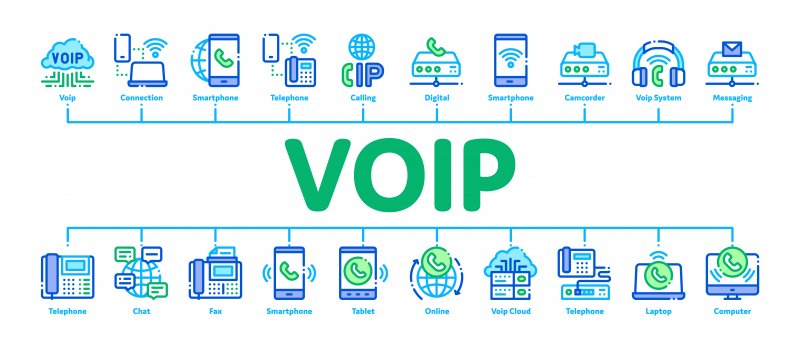No company can do business without clear and reliable methods of communication. When expensive or low-quality phone, video, or chat is an issue, SIP trunking can be the answer.
Organizations that hesitate to use session initiation protocol trunking should be aware that the market continues to grow, meaning their competitors are likely already using these services for a competitive edge. Discover how this technology can improve a business’s communications in 2023, plus some common challenges.
What Does SIP Trunking Do?
SIP trunking connects virtual phone lines to a physical PBX, allowing companies to use Voice over Internet Protocol on their existing equipment. The service also enables the organization to bring other connected devices into the system.
Voice calls, video communication, chat, conferencing, and more work together in one unified Communications as a Service platform. This UCaaS setup allows a company to keep its legacy PBX, justify the costs of a new PBX, or implement gradual plans to transition to a fully hosted PBX.
What are the Benefits of SIP Trunking?
SIP trunking provides various advantages to companies of all types and sizes that rely on internal and external communications.
Flexibility With Scaling
With analog systems, a company can only have as many lines as the system physically permits. Each phone requires a connection, and installing and maintaining the setup involves the work of a technician. SIP trunking lets a business add as many lines as it wishes. It can also reduce connections when necessary without concerns about maintaining an unused line.
The cloud capabilities allow a company to implement a bring-your-own-device system, which can create additional savings and advantages. This feature opens the door to remote work and a vast pool of qualified international workers.
Backup and Security
The primary advantage of on-premises PBX systems is the level of control the owners have over them. However, preserving that security requires paying an in-house team or making IT arrangements with another company, which might involve excessive downtime while waiting for service.
A SIP trunking provider cares for security issues and has data centers for backup. The best providers maintain data centers in multiple locations to comply with data and privacy laws and meet industry regulations. A company no longer has to invest in an on-premises system to address security concerns.
Continuity
Any downtime equals lost revenue. Depending on the service, an outage or blackout could be when customers most need the assistance of a business.
Companies must do more than have data backup solutions and emergency power. SIP trunking reroutes calls to other offices or mobile devices, minimizing the impact of an outage and allowing a company to keep running.
Clients cannot tell any difference and will appreciate the preparation and consistency. Once the primary office or location is back online, functions can return to normal.
Unified Communications
With a physical system, each additional element might require separate services for features such as voice, video, chat, and data. Running communications over the internet means one provider can handle multiple services under one roof. UCaaS offers convenience for productivity.
Video Embed: What is Intermedia Unite?
Lower Costs
Companies can save up to 50% on telephone costs by adopting SIP trunking. Not only is the physical infrastructure not an issue, but VoIP calls also eliminate additional fees for international and long-distance calls.
What are the Challenges of SIP Trunking?
SIP trunking may seem like a no-lose proposition. However, the service can present challenges, especially when an organization implements it incorrectly or without the necessary expertise.
Compatibility
Some communications vendors are not able to work with a company’s current phone system. A business must find a provider that works with all standard PBXs and has the tools to implement SIP trunking with other services.
Bandwidth
Companies need to review their internet plan to ensure they have sufficient bandwidth for call volume at peak traffic with no interruptions. Accessing high-definition VoIP calls with SIP trunking is not possible without the internet speeds to handle the load.
The decision requires a balancing act, as a company could fall prey to overprovisioning. While more bandwidth can be a safe decision, a company has to make calculations to allocate capital to the proper resources.
Security
Security is a benefit only when users monitor it and use the right vendor with adequate policies. A business must verify its provider has resiliencies in place to eliminate points of failure during a disaster or outage. It also needs data centers in suitable locations for compliance with company policies and local laws.
Missing Features
A communications provider must have all the features a business needs to continue to offer excellent service. For example, a business’s customers may prefer faxing. If the UCaaS provider does not have online faxing, the company should look elsewhere.
Additionally, E911 services can be vital for emergencies. Cost savings are not worth sacrificing the safety of the team.
The real issue when it comes to SIP trunking difficulties involves having adequate resources and training for the solutions. As long as the business pairs with the right vendor who can serve as a guide and consultant from onboarding to full operation, challenges will be few.
The Right Vendor for Implementing SIP Trunking
Robust communications services are crucial to running a successful business. SIP trunking allows companies to connect their phone systems to the internet and take advantage of the efficiency, continuity, and cost savings of VoIP.
Contact Intermedia for expert help in modernizing your organization’s phone system.
February 13, 2023
Explore other posts on these topics:



